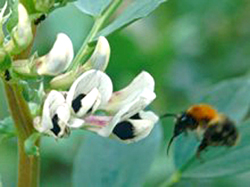Foraging scent-marks in bees |
|||
DFG Project EL 249/4Insect epicuticular lipids are known to serve a range of functions, including the reduction of evaporative water loss over the body surface as well as improving adhesion for movement on smooth surfaces. Additionally, the same lipids may constitute chemical signals for conspecifics, e.g mediate mate recognition or relate information on reproductive status. In foraging bees, especially bumblebees (Bombus sp.), epicuticular lipids are thought to function as scent marks, that allow foragers to detect and avoid flowers that have been previously visited and depleted by themselves or other individuals (Goulson et al. 1998; Gawleta et al. 2005). When approaching an inflorescence bumblebee workers can often been seen to briefly hover in front of a given flower, but then reject it without actually probing for nectar. As the rejected flowers contain on average less nectar than probed flowers, discrimination minimizes search time and energy expenditure. Behavioral experiments by D. Goulson and coworkers have indicated that the remote assessment of flowers is not based on a direct perception of nectar rewards but rather indirectly on the perception of hydrocarbon marks deposited by previous visitors. Flowers treated with hexane extracts of bumblebee tarsi elicited a repellent effect similar to that of a natural bumblebee visit, with nectar levels remaining unaltered. Similar results were obtained when applying to flowers several pure synthetic hydrocarbons (n-alkanes, alkenes), which had been previously shown to be the main contents of epicuticular lipids (Goulson et al. 2000). It is still unclear whether the deposition of repellent substances is an active process that merits the term 'scent marking' or whether the deposits are mere unavoidable 'footprints'. As a further corollary the repellent effect is only temporary. Normally repellency of visited flowers is lost after 30 to 60 minutes depending on flower species/rate of nectar secretion (Stout and Goulson 2001). In our research we address the following questions:1. Are scent marks deposited by individual visitors detectable on artificial or natural flowers? 2. Is scent-marking active or passive, i.e. are scent-marks specific pheromone signals released to transfer information(e.g. to self) or simple footprint cues deposited wherever a bee walks? 3. Is flower discrimination context-dependent, i.e do foraging bees evaluate scent marks in relation to ressource levels and discriminate accordingly? 4. Is detection of foraging scents confined to certain bee taxa (e.g. bumblebees and honeybees), or is it more broadly distributed among bees and other flower visiting insects? 5. Is recognition of repellent scents hard-wired or does it require repeated negative conditioning? 6. Are deposited substances sufficiently volatile to reflect replenishing nectar levels? How is rapid loss of repellency mediated? 7. Can bee hydrocarbon signatures on flowers be used to reconstruct the visitation history of a given flower? References: Stout, J. C., Goulson, D. & Allen, J. A. 1998. Repellent scent-marking of flowers by a guild of foraging bumblebees (Bombus spp.). Behavioral Ecology and Sociobiology 43, 317-326. Goulson, D., Stout, J. C., Langley, J. & Hughes, W. O. H. 2000. Identity and function of scent marks deposited by foraging bumblebees. Journal of Chemical Ecology 26, 2897-2911. Stout, J. C. & Goulson, D. 2001. The influence of nectar secretion rates on the responses of bumblebees (Bombus spp.) to previously visited flowers. Behavioral Ecology and Sociobiology 52, 239-246. Gawleta, N., Zimmermann, Y. & Eltz, T. 2005. Repellent foraging scent recognition across bee families. Apidologie 36, 325-330. Eltz T., 2006. Tracing pollinator footprints on natural flowers. Journal of Chemical Ecology 32, 907-915. Witjes, S. & Eltz, T. 2007. Influence of scent deposits on flower choice: experiments in an artificial flower array with bumblebees. Apidologie 38, 12-18. Wilms, J. & Eltz, T. 2008. Foraging scent marks of bumblebees: footprint cues rather than pheromone signals. Naturwissenschaften 95: 149-153. PDF |
|
RUB » Dekanat für Biologie und Biotechnologie » Evolutionsökologie und Biodiversität der Tiere - Mitarbeiterhomepage PD Dr. Th. Eltz


